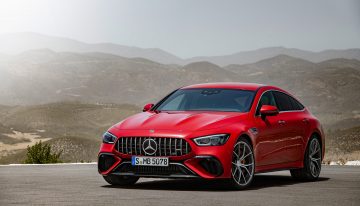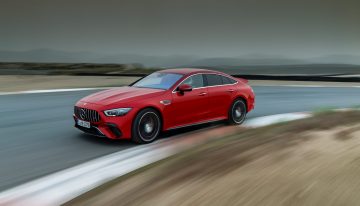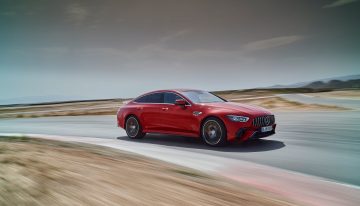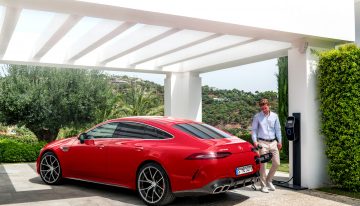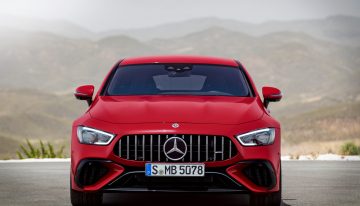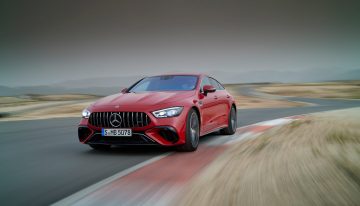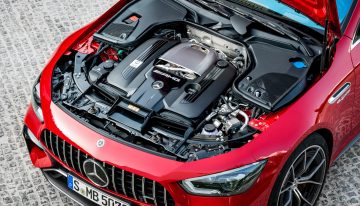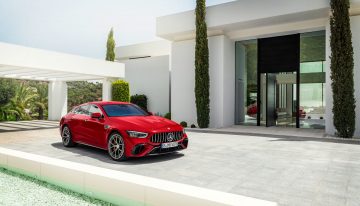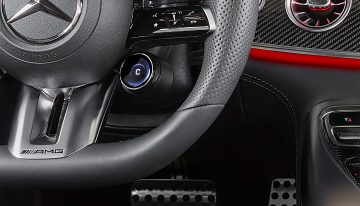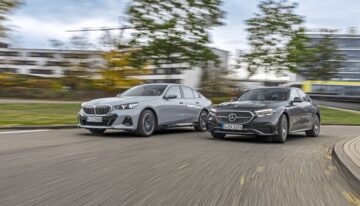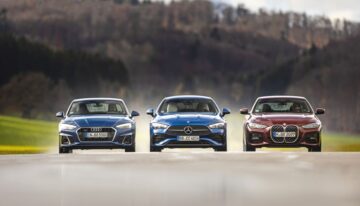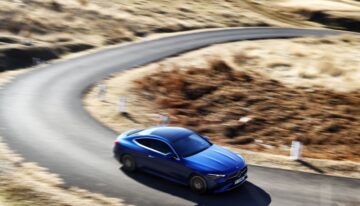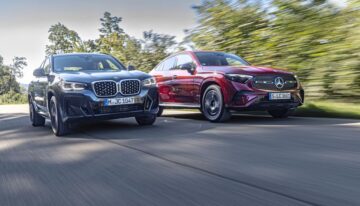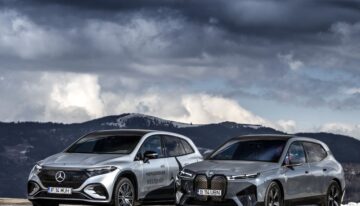The German magazine auto motor und sport compared the two concepts: the high-performance Plug-In Hybrid Mercedes-AMG GT 63 S E-Performance and the electric Porsche Taycan Turbo S. Which is more appropriate?
Surprise: Mercedes-AMG GT 63 S E Performance is heavier
The high-performance Plug-In Hybrid model from Mercedes with V8 engine and electric motor weighs 2305 kg while Porsche Taycan Turbo S with two electric motors and all-wheel drive has 10 kg less. What is the best concept?
Mercedes presented at the IAA at Munchen in the autumn of 2021 the high-performance PHEV model Mercedes-AMG GT 63 S E-Performance which is the most powerful PHEV in the segment: 843 HP and more than 1400 Nm (1470 Nm estimated by auto motor und sport).
The 4-liter twin-turbo V8 engine with 639 HP with integrated starter generator sends power to all four wheels via the 9-speed automatic transmission while the 204 HP electric motor drives the rear axle via its own two-speed gearbox. The system is complicated and also weighs 185 kg more than the conventional version with V8 bi-turbo engine. However, the PHEV model from Mercedes is 45 kg lighter than its direct competitor Porsche Panamera Turbo S E Hybrid but 10 kg heavier than the Porsche Taycan Turbo S.
Thus, the Taycan Turbo S electric model no longer seems so heavy despite the fact that only its battery weighs 650 kg. By comparison, the battery of the Mercedes-AMG GT S E Performance weighs only 89 kg and under it is placed the 66 liter petrol tank. But the Taycan has the advantage of a battery placed in the floor that lowers the center of gravity 2 cm lower than the 911. Instead, Mercedes-AMG does not have this advantage and in addition, it is a larger car: with a length of 5.05 meters and a wheelbase of 2.95 m is 9 cm longer and the wheelbase is only 5 cm longer than the Taycan.
Mercedes-AMG GT 63 S E Performance has more power and torque
Mercedes-AMG GT 63 S E Performance is stronger. Taycan has a maximum of 761 HP but only for 2.5 seconds because in the rest of the time has only 625 HP. Thus, Mercedes has 82 HP more than Taycan and the torque is 400 Nm higher (Taycan 1050 Nm). The torque difference is huge and represents, for example, the torque of a high-performance 2-liter diesel engine.
Although the power of 761 HP is delivered for a shorter time (2.5 s) than necessary to accelerate from 0 to 100 km/h, the Taycan is still very fast: in 2.8 s it reaches 100 km/h while Mercedes needs a tenth of a second more: 2.9 s. Taycan also benefits from the 2-speed automatic transmission, a rarity in the field of electric cars that gives it both fast acceleration and a top speed of 260 km/h. AMG reaches 316 km/h. But for Taycan more important is the range specially when driving at high speeds.
Porsche is more economic but has less range
Porsche has a 93.4 kWh battery, a large capacity for an electric car but from an energy point of view, it is the equivalent of only 11 liters of gasoline. Mercedes-AMG GT 63 S E Performance would not cover even 100 km with 11 l of gasoline. Instead, the Taycan Turbo S has a range between 390 and 416 km corresponding to a consumption of 25 kWh/100 km which is equivalent to a consumption of 3 l / 100 km.
But in the WLTP cycle the maximum speed is 120 km/h and only for a short period, so this consumption is not relevant when going at high speed.
Colleagues from auto motor und sport magazine managed a record to cover 3000 km with the Taycan Turbo S in 24 hours, the average speed being 127 km/h. Consumption was below 40 kWh/100 km, the equivalent of 4.9 l / 100 km gasoline. But they had to stop 30 times to charge the battery.
On the other hand, AMG has a small battery of only 6.1 kWh as will the future AMG C 63 which gives it an electric range between 12 and 14 km. But it also has a 66-liter tank, 14 liters smaller than the conventional model. A smaller tank does not mean that the PHEV is more economic than conventional version, because sometimes V8 uses some of the power to keep the battery charge level at a certain value.
AMG’s 8.6 l/100 km (full battery) official WLTP consumption is fantastic. At high speed, it is probable that the Taycan does not travel more than 200 km. AMG certainly goes above and beyond. A few years ago, with the AMG GT S I need almost 30 l/100 km in a super sporty ascent and descent on Transfagarasan, the most beautiful road in the world. But this was an extreme drive.
At Taycan you need 5.5 minutes to charge power for 100 km, or at least 22.5 minutes from 5 to 80% but only if you have a high power DC station that are rare.
Porsche is a little more spacious
Theoretically, these cars offer four seats but often only two people will travel. But it should be noted that Porsche has built a revolutionary battery that has a whole in the area of the rear passenger’s feet that do not sit with their knees in the air. And there is enough room for the head, although Taycan is 6 cm less tall and has a Cx of 0.25 (AMG 0.32).
And surprisingly, Porsche has a 30 liter larger trunk in the rear and in addition has an 81 l trunk in the front. In total, the Porsche has a storage space 122 liters larger than the AMG which is 9 cm longer and has a trunk of only 335 liters, similar to the VW Golf and 120 liters smaller than the AMG GT 63 S conventional model.
Verdict
With the Mercedes-AMG GT 63 S E Performance Mercedes has pursued dynamic performance in the first place while efficiency is in the background because it drives electrically over very short distances. Therefore, the objective advantages over Porsche are few: it is a little faster and has more range. The lap times obtained separately from each one on the race track seem to be to AMG’s advantage, but here the tires are important and we expect a direct confrontation in the same conditions.


